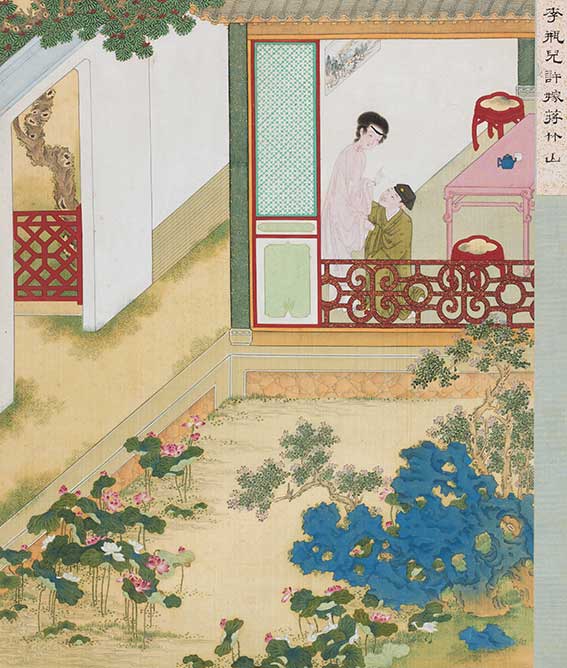As subjects, glamorous women in Chinese art appear in numerous guises, from deities and mothers to court ladies and courtesans. As early as 600 BC, Chinese women’s roles in society were primarily centred within the home. By the Tang dynasty (618-907), a growing interest in the depiction of daily life in the palace led to the establishment of a new category of painting that portrayed beautiful women. Images of elegant court ladies engaged in leisure activities were especially popular – the dignified female figures represented in these paintings served not as specific portraits, but rather as idealised images that reflected contemporary standards of feminine beauty. These standards of physical beauty changed from era to era, but what seems to remain constant is the desire to also align female beauty not only with talent and accomplishments, but also with moral virtue and sacrifice.
The Role of Confucianism
This role for glamorous women in Chinese art was informed by Confucianism, which promoted the view of a harmonious societal order, elevating men as the household authorities and assigning women to domestic roles. By illustrating exemplary women engaged in duties and activities appropriate to their designated station in life according to patriarchal Confucian principles, where women did not determine the course of their own lives. As a result, women’s contributions to society were largely overlooked.
Early genre works like shinu hua (painting of gentlewomen) portrayed women as exemplary models of beauty and femininity. In later Chinese painting, meiren hua (beautiful women paintings) also reflected these tastes, echoing the fashion of the period. These anonymous beauties demonstrate how traditional representations of women in Chinese art were primarily founded upon widely accepted stereotypes held by society in general – and male painters in particular. However, despite these strictures, women played a critical role in creating and sustaining the economic and cultural fabric of Chinese society.
Shin Hua, Painting of Gentlewoman
By the 16th century, shinu hua had expanded to represent women across society. These were not individual portraits, rather the women were identified by their social roles. Using visual clues, the viewer can identify the figures depicted as palace women, upper-class ladies, historical figures, courtesans (women trained as entertainers for men), or concubines (secondary or even lower-ranking wives). After the 1700s, artists gradually started to portray specific individuals. For example, portraits of senior women or matrons of a family were often commissioned by family members to honour them. The settings, hairstyles, costumes, and accoutrements that surround these female figures often provide the visual clues necessary to determine the woman’s identity or social rank. Although many of the artists who created these works remain unknown, those that are documented are typically men.
Artists later revamped this portrait-painting tradition to illustrate women as provocative seductresses as described in popular Chinese literature. This other side to these virtuous paintings includes depictions of the seductress – portraits of women with fanciful coiffures, perfect complexions, and luxurious silk dresses. Often taken from Chinese literature, like the 18th-century illustration of Li Pinger Agreeing to Marry Jian Zushan, from Jinpingmei (The Plum in the Golden Vase), a novel of manners from the late 16th century that tells the story of several daring concubines and mistresses in the circle of a corrupt merchant, Master Ximen.
The leading women, Golden Lotus (Pan Jinlian) and Little Vase (Li Ping’er), not only enjoy seducing men but also plot malicious schemes to gain access to their affluent lifestyles. To convey both the luxurious lifestyle and eroticism in the novel, the painters depict these women with fashionable hairdos and colourful outfits. Looking closely, some women slip their tiny bound feet from under their long skirts, subtly suggesting they are available. When her lover Master Ximen is away, out of loneliness, Little Vase (Li Ping’er) takes the opportunity to marry a man who has come to her home.
Femmes Fatales in Chinese Art
These fictional seductresses were often portrayed as femmes fatales and depict a genre of glamorous women in Chinese art, whose dangerous acts of seduction caused harm, specifically to a man’s career and status in society, and who were often demons or monsters in disguise, or played by concubines (lower-ranking wives). In these paintings, women are mainly portrayed as being fashionable, showing traits of the concepts of beauty of the time, including bound feet.
The portrayal of fashionable women reflects the changes that had occurred in Chinese society by the 19th century – women who used fashion and accessories to transform themselves from silent muses to fashionable trendsetters in this transformed world. In this new era, when more women could partake in fashion, new fashions trends began to quickly emerge, as the media encouraged more socially open lifestyles. Urban women of the Han Chinese, the ethnic majority of China’s population, promoted these new fashions, like the silk jacket, skirt, and other accessories worn for special occasions. By the end of the 19th century, imported chemical dyes and patterned ribbons from Europe enabled a more colourful palette and new designs for garments and accessories. These styles later influenced the clothing for Manchu women from ruling-class families.
By looking closely at visual clues and symbolism embedded within these works, we can learn more about women’s lives, their beauty ideals, and their overall influence on art and culture. These women’s images, executed with refined brushwork and vibrant colours, are often accompanied by rich objects, such as plants and antiques, which provide indications of societal expectation or their roles. Viewed together, we see how women impacted Chinese art and culture much more fully than what we know from written history. Art depicting women and fashions created by and for women highlight their crucial impact as tastemakers in visual culture from the 12th to the 19th centuries.
Until 19 May, 2024, Nelson Atkins Museum of Art, Kansas City, nelson-atkins.org








